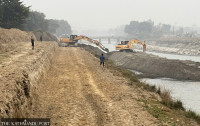National
Local governments say they don’t get enough resources
The federal government needs to hand over their constitutional responsibilities as well as staff to sub-national governments, experts say.
Prithvi Man Shrestha
Prime Minister KP Sharma Oli on March 24 said that allocating 70 percent of the total budget of the federal government to the local governments as demanded by some of them would be impractical.
“What do you do with 70 percent of the budget?” he asked while addressing the 28th anniversary of the Municipal Association. “Will it be used to sleep on?”
Prime Minister Oli’s remark has come at a time when the government led by him is facing accusations of undermining federalism by overstepping the jurisdictions of provincial and local governments.
Both provincial and local governments have been complaining that the federal government has concentrated the resources with it despite a significant chunk of activities being handed over to them from the central government.
“Budget distribution to the local level has not been reflected in overall work that local governments are supposed to do as per the constitution and laws,” said Ashok Kumar Byanju (Shrestha), president of Municipal Association of Nepal, a grouping of the municipalities.
In the current fiscal year, the government allocated Rs362.63 billion to the provincial and local governments under four headings—fiscal equalisation, conditional, special and complementary grants. The amount is around 25 percent of the total Rs1.47 trillion budget presented by the federal government in May last year.
According to the Finance Ministry, the seven provinces received Rs99.87 billion while 754 local governments were allocated Rs262.75 billion.
It means the provincial governments were allocated 6.77 percent of the total budget while nearly 18 percent was allocated to local governments. There are seven provinces and 754 local governments in the country.
Experts on federalism say that although the budget allocated for local governments has increased substantially and there is now budget for provincial governments after the country introduced a federal set-up, whether that is enough should be calculated based on whether the sub-national governments can spend the available budget well.
“As a per a study that I prepared for the Prime Minister’s Office right after the promulgation of the constitution in 2015, as much as 60 percent work of the government was supposed to be done by provincial and local governments as per constitutional provisions,” said Khim Lal Devkota, an expert on fiscal federalism and local government.
“But the budget earmarked for them does not reflect this workload of the sub-national governments. Besides, many of the responsibilities to be carried out by the sub-national governments are yet to be handed over to them due to the lack of relevant laws.”
The federal government continues to be involved in constructing local level roads and bridges as well as other small infrastructure projects. Appendix 5 of the Constitution of Nepal says only the national highways come under the purview of the federal government. This means other smaller highways and roads and bridges are the responsibility of provincial or local governments.
The Department of Local Infrastructure, which was reconstituted from the Department of Local Infrastructure Development and Agricultural Roads (Dolidar) under the federal affairs ministry, gets involved in undertaking planning and assisting for the construction of local-level rural roads, irrigation and river control, water supply and sanitation, suspension bridge, housing and building and rural energy, among others.
The federal government continues to maintain its presence in local schools by establishing the Education Development and Coordination Unit, which has been assigned to maintain records of teachers, to conduct exams for grades 10, 11 and 12, and liaise between the federal and local governments to implement the centre’s projects.
Province 2 government has taken the federal government to the court blaming the central government for overstepping into the provincial government’s jurisdictions.
In August 2019, the Province 2 government filed a writ at the Supreme Court challenging the central government’s move to merge the Sagarnath Forest Development Project with the Timber Corporation of Nepal. In December last year, it moved the Supreme Court to annul the federal government’s decision to claim jurisdiction on groundwater resources development, calling it unconstitutional.
Byanju, who is also the mayor of Dhulikhel Municipality, said besides overstepping into sub-national governments’ jurisdictions, the federal government’s failure to introduce a number of federal laws has also obstructed the transfer of many functions to local governments.
Devkota said that the fiscal transfer for the sub-national government could be even higher than what is now if the central government handed over their constitutional functions to them.
But it is not just a matter of asking for more funds.
According to Devkota, whether a budget allocated by the federal government was enough for a sub-national government should also be judged by their ability to spend the allocated budget.
Provincial and local governments have been weaker in terms of the expenditure compared to the federal government whose own performance has continued to remain poor.
According to the Financial Comptroller General Office, the office responsible for releasing the budget and keeping records of income and expenditures of the government, the combined expenditure of the provincial governments in the fiscal year 2019-20 stood at just 67.29 percent with Karnali province being able to spend just 50 percent of its budget, the lowest among the seven provinces.
When it comes to local governments, they spent just 68.45 percent of their combined budget.
The federal government’s expenditure in the last fiscal year stood at 71.18 percent.
With the federal government collecting 80 percent of total revenue in the last fiscal year, the province and local governments heavily relied on the fiscal transfer from the federal government. In the last fiscal year, the provincial governments contributed just 6.73 percent of total revenue while the local governments contributed 12.94 percent of total revenue collected by three layers of the government.
Devkota said that the local governments should not seek more fiscal transfer from Kathmandu alone but also try to raise their own resources as they have many avenues to raise taxes.
“The local and provincial governments should not depend on fiscal transfer from the federal government as they also have room for raising a lot of taxes,” said Devkota.
Local governments collect a number of taxes including on property, house rent, house land registration, vehicles, services, advertisements, business transactions, land, and entertainment.
Former chief secretary Somlal Subedi, who also has expertise on fiscal federalism, told the Post that he could not immediately comment on whether the fiscal transfer to provincial and local governments from the central government was enough.
“We can reach a conclusion on this only after examining the functions, financial resources, human resources and the achievements of the provincial and local governments,” he said. “Resources, however, have increased substantially for the local governments compared after the country implemented federalism.”
But it is not just a matter of fiscal resources and functions. Human resource is another aspect of the devolution of governance.
Sub-national governments, however, complain that the federal government failing to send adequate staff, particularly technical staff, to the provincial and local governments while preventing them from recruiting new staff, contributed to the lower than expected expenditure.
During the employees adjustment process, the federal government retained most of its employees although it had announced prioritising adjustment of staff at the local level.
“We have more functions but have limited budget and employees to implement them,” said Byanju.




 10.12°C Kathmandu
10.12°C Kathmandu















